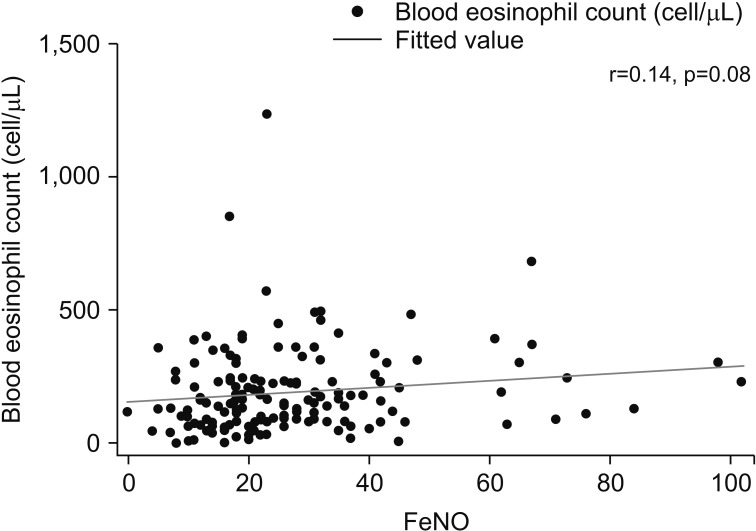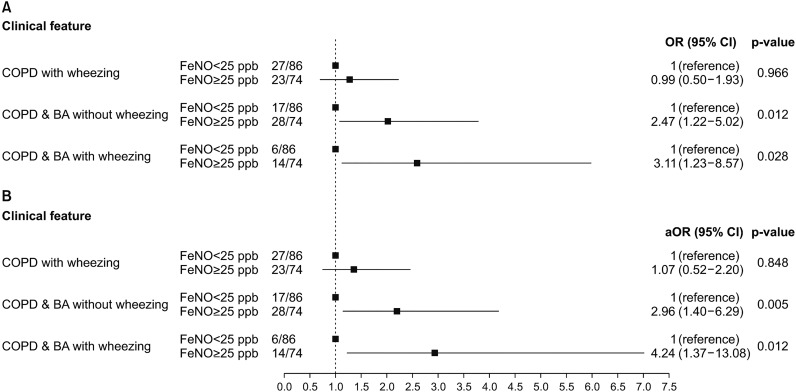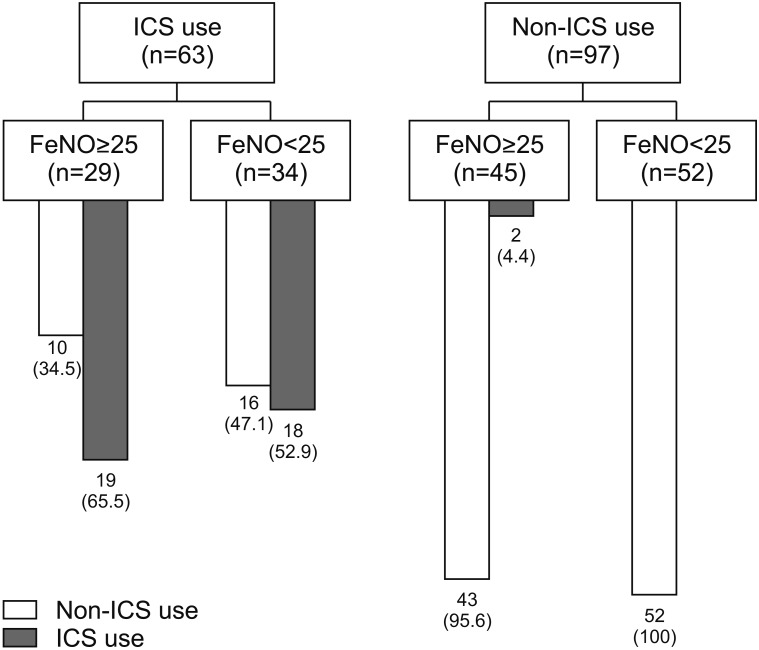Tuberc Respir Dis.
2020 Jan;83(1):42-50. 10.4046/trd.2019.0050.
Exhaled Nitric Oxide in Patients with Stable Chronic Obstructive Pulmonary Disease: Clinical Implications of the Use of Inhaled Corticosteroids
- Affiliations
-
- 1Division of Pulmonary, Allergy, and Critical Care Medicine, Department of Internal Medicine, Hallym University Kangdong Sacred Heart Hospital, Seoul, Korea.
- 2Division of Pulmonary and Critical Care Medicine, Department of Medicine, Samsung Medical Center, Sungkyunkwan University School of Medicine, Seoul, Korea. hyeyunpark@skku.edu
- 3Division of Pulmonary and Critical Care Medicine, Department of Internal Medicine, Ilsan Paik Hospital, Inje University College of Medicine, Goyang, Korea.
- 4Division of Pulmonary, Allergy, and Critical Care Medicine, Department of Internal Medicine, Yonsei University Wonju Severance Christian Hospital, Yonsei University Wonju College of Medicine, Wonju, Korea.
- 5Department of Internal Medicine, Chonnam National University Hospital, Gwangju, Korea.
- 6Department of Medicine, Ulsan University Hospital, University of Ulsan College of Medicine, Ulsan, Korea.
- 7Division of Pulmonary and Allergy Medicine, Department of Internal Medicine, Konkuk University School of Medicine, Seoul, Korea.
- 8Divsion of Pulmonary, Allergy and Critical Care Medicine, Department of Internal Medicine, Hallym University Sacred Heart Hospital, Anyang, Korea.
- 9Division of Pulmonary, Allergy, and Critical Care Medicine, Department of Internal Medicine, Hallym University Kangdong Sacred Heart Hospital, Seoul, Korea. bfspark2@gmail.com
- KMID: 2466619
- DOI: http://doi.org/10.4046/trd.2019.0050
Abstract
- BACKGROUND
Fractional exhaled nitric oxide (FeNO) is regarded as a potential biomarker for identifying eosinophilic inflammation. We aimed to evaluate the clinical implication of FeNO and its influence on inhaled corticosteroids (ICS) prescription rate in Korean chronic obstructive pulmonary disease (COPD) patients.
METHODS
FeNO level and its association with clinical features were analyzed. Changes in the prescription rate of ICS before and after FeNO measurement were identified.
RESULTS
A total of 160 COPD patients were divided into increased (≥25 parts per billion [ppb], n=74) and normal (<25 ppb, n=86) FeNO groups according to the recommendations from the American Thoracic Society. Compared with the normal FeNO group, the adjusted odds ratio for having history of asthma without wheezing and with wheezing in the increased FeNO group were 2.96 (95% confidence interval [CI], 1.40-6.29) and 4.24 (95% CI, 1.37-13.08), respectively. Only 21 out of 74 patients (28.4%) with increased FeNO prescribed ICS-containing inhaler and 18 of 86 patients (20.9%) with normal FeNO were given ICS-containing inhaler. Previous exacerbation, asthma, and wheezing were the major factors to maintain ICS at normal FeNO level and not to initiate ICS at increased FeNO level.
CONCLUSION
Increased FeNO was associated with the history of asthma irrespective of wheezing. However, FeNO seemed to play a subsidiary role in the use of ICS-containing inhalers in real-world clinics, which was determined with prior exacerbation and clinical features suggesting Th2 inflammation.
Keyword
MeSH Terms
Figure
Reference
-
1. Bellocchia M, Masoero M, Ciuffreda A, Croce S, Vaudano A, Torchio R, et al. Predictors of cardiovascular disease in asthma and chronic obstructive pulmonary disease. Multidiscip Respir Med. 2013; 8:58. PMID: 24004921.
Article2. Price D, West D, Brusselle G, Gruffydd-Jones K, Jones R, Miravitlles M, et al. Management of COPD in the UK primary-care setting: an analysis of real-life prescribing patterns. Int J Chron Obstruct Pulmon Dis. 2014; 9:889–904. PMID: 25210450.3. Vestbo J, Vogelmeier C, Small M, Higgins V. Understanding the GOLD 2011 Strategy as applied to a real-world COPD population. Respir Med. 2014; 108:729–736. PMID: 24675239.4. Worth H, Buhl R, Criee CP, Kardos P, Mailander C, Vogelmeier C. The ‘real-life’ COPD patient in Germany: The DACCORD study. Respir Med. 2016; 111:64–71. PMID: 26775251.5. Eriksson KO, Naidu AS, Kilar F, Wadstrom T, Hjerten S. Surface hydrophobicity and electrophoretic mobilities of staphylococcal exotoxins with special reference to toxic shock syndrome toxin-1. APMIS. 1989; 97:1081–1087. PMID: 2611023.6. Gonzalez AV, Coulombe J, Ernst P, Suissa S. Long-term use of inhaled corticosteroids in COPD and the risk of fracture. Chest. 2018; 153:321–328. PMID: 28716642.7. Price D, Yawn B, Brusselle G, Rossi A. Risk-to-benefit ratio of inhaled corticosteroids in patients with COPD. Prim Care Respir J. 2013; 22:92–100. PMID: 23135217.8. Di Stefano A, Capelli A, Lusuardi M, Balbo P, Vecchio C, Maestrelli P, et al. Severity of airflow limitation is associated with severity of airway inflammation in smokers. Am J Respir Crit Care Med. 1998; 158:1277–1285. PMID: 9769292.9. Saha S, Brightling CE. Eosinophilic airway inflammation in COPD. Int J Chron Obstruct Pulmon Dis. 2006; 1:39–47. PMID: 18046901.
Article10. Christenson SA, Steiling K, van den Berge M, Hijazi K, Hiemstra PS, Postma DS, et al. Asthma-COPD overlap. Clinical relevance of genomic signatures of type 2 inflammation in chronic obstructive pulmonary disease. Am J Respir Crit Care Med. 2015; 191:758–766. PMID: 25611785.11. Barnes PJ. Therapeutic approaches to asthma-chronic obstructive pulmonary disease overlap syndromes. J Allergy Clin Immunol. 2015; 136:531–545. PMID: 26343937.12. Brightling CE, Monteiro W, Ward R, Parker D, Morgan MD, Wardlaw AJ, et al. Sputum eosinophilia and short-term response to prednisolone in chronic obstructive pulmonary disease: a randomised controlled trial. Lancet. 2000; 356:1480–1485. PMID: 11081531.13. Brightling CE, McKenna S, Hargadon B, Birring S, Green R, Siva R, et al. Sputum eosinophilia and the short term response to inhaled mometasone in chronic obstructive pulmonary disease. Thorax. 2005; 60:193–198. PMID: 15741434.14. Bafadhel M, McKenna S, Terry S, Mistry V, Pancholi M, Venge P, et al. Blood eosinophils to direct corticosteroid treatment of exacerbations of chronic obstructive pulmonary disease: a randomized placebo-controlled trial. Am J Respir Crit Care Med. 2012; 186:48–55. PMID: 22447964.15. Barnes NC, Sharma R, Lettis S, Calverley PM. Blood eosinophils as a marker of response to inhaled corticosteroids in COPD. Eur Respir J. 2016; 47:1374–1382. PMID: 26917606.16. Negewo NA, McDonald VM, Baines KJ, Wark PA, Simpson JL, Jones PW, et al. Peripheral blood eosinophils: a surrogate marker for airway eosinophilia in stable COPD. Int J Chron Obstruct Pulmon Dis. 2016; 11:1495–1504. PMID: 27445469.17. Bafadhel M, Peterson S, De Blas MA, Calverley PM, Rennard SI, Richter K, et al. Predictors of exacerbation risk and response to budesonide in patients with chronic obstructive pulmonary disease: a post-hoc analysis of three randomised trials. Lancet Respir Med. 2018; 6:117–126. PMID: 29331313.18. Global Initiative for Chronic Obstructive Lung Disease. Global strategy for the diagnosis, management, and prevention of chronic obstructive pulmonary disease: 2019 update [Internet]. Fontana, WI: Global Initiative for Chronic Obstructive Lung Disease;2019. cited 2019 Feb 15. Available from: http://www.goldcopd.org.19. Shin SH, Park HY, Kang D, Cho J, Kwon SO, Park JH, et al. Serial blood eosinophils and clinical outcome in patients with chronic obstructive pulmonary disease. Respir Res. 2018; 19:134. PMID: 30001715.
Article20. Southworth T, Beech G, Foden P, Kolsum U, Singh D. The reproducibility of COPD blood eosinophil counts. Eur Respir J. 2018; 52:1800427. PMID: 29724922.
Article21. Jatakanon A, Lim S, Kharitonov SA, Chung KF, Barnes PJ. Correlation between exhaled nitric oxide, sputum eosinophils, and methacholine responsiveness in patients with mild asthma. Thorax. 1998; 53:91–95. PMID: 9624291.22. Berlyne GS, Parameswaran K, Kamada D, Efthimiadis A, Hargreave FE. A comparison of exhaled nitric oxide and induced sputum as markers of airway inflammation. J Allergy Clin Immunol. 2000; 106:638–644. PMID: 11031333.23. Price DB, Buhl R, Chan A, Freeman D, Gardener E, Godley C, et al. Fractional exhaled nitric oxide as a predictor of response to inhaled corticosteroids in patients with nonspecific respiratory symptoms and insignificant bronchodilator reversibility: a randomised controlled trial. Lancet Respir Med. 2018; 6:29–39. PMID: 29108938.24. Lee JY, Chon GR, Rhee CK, Kim DK, Yoon HK, Lee JH, et al. Characteristics of patients with chronic obstructive pulmonary disease at the first visit to a pulmonary medical center in Korea: The KOrea COpd Subgroup Study Team Cohort. J Korean Med Sci. 2016; 31:553–560. PMID: 27051239.25. Pellegrino R, Viegi G, Brusasco V, Crapo RO, Burgos F, Casaburi R, et al. Interpretative strategies for lung function tests. Eur Respir J. 2005; 26:948–968. PMID: 16264058.26. Choi JK, Paek D, Lee JO. Normal predictive values of spirometry in Korean population. Tuberc Respir Dis. 2005; 58:230–242.
Article27. Dweik RA, Boggs PB, Erzurum SC, Irvin CG, Leigh MW, Lundberg JO, et al. An official ATS clinical practice guideline: interpretation of exhaled nitric oxide levels (FENO) for clinical applications. Am J Respir Crit Care Med. 2011; 184:602–615. PMID: 21885636.28. Kim JH, Yim JJ. Achievements in and challenges of tuberculosis control in South Korea. Emerg Infect Dis. 2015; 21:1913–1920. PMID: 26485188.29. Pavord ID, Lettis S, Locantore N, Pascoe S, Jones PW, Wedzicha JA, et al. Blood eosinophils and inhaled corticosteroid/long-acting beta-2 agonist efficacy in COPD. Thorax. 2016; 71:118–125. PMID: 26585525.30. Su VY, Yang KY, Yang YH, Tsai YH, Perng DW, Su WJ, et al. Use of ICS/LABA combinations or LAMA is associated with a lower risk of acute exacerbation in patients with coexistent COPD and asthma. J Allergy Clin Immunol Pract. 2018; 6:1927–1935. PMID: 29432960.31. Oshagbemi OA, Burden AM, Braeken DC, Henskens Y, Wouters EF, Driessen JH, et al. Stability of blood eosinophils in patients with chronic obstructive pulmonary disease and in control subjects, and the impact of sex, age, smoking, and baseline counts. Am J Respir Crit Care Med. 2017; 195:1402–1404. PMID: 28165763.32. Vedel-Krogh S, Nielsen SF, Lange P, Vestbo J, Nordestgaard BG. Blood eosinophils and exacerbations in chronic obstructive pulmonary disease. The Copenhagen General Population Study. Am J Respir Crit Care Med. 2016; 193:965–974. PMID: 26641631.33. Dweik RA, Comhair SA, Gaston B, Thunnissen FB, Farver C, Thomassen MJ, et al. NO chemical events in the human airway during the immediate and late antigen-induced asthmatic response. Proc Natl Acad Sci U S A. 2001; 98:2622–2627. PMID: 11226289.34. Antus B, Barta I, Horvath I, Csiszer E. Relationship between exhaled nitric oxide and treatment response in COPD patients with exacerbations. Respirology. 2010; 15:472–477. PMID: 20210889.35. Soter S, Barta I, Antus B. Predicting sputum eosinophilia in exacerbations of COPD using exhaled nitric oxide. Inflammation. 2013; 36:1178–1185. PMID: 23681903.36. Colak Y, Afzal S, Nordestgaard BG, Marott JL, Lange P. Combined value of exhaled nitric oxide and blood eosinophils in chronic airway disease: the Copenhagen General Population Study. Eur Respir J. 2018; 52:1800616. PMID: 29903861.37. Chen FJ, Huang XY, Liu YL, Lin GP, Xie CM. Importance of fractional exhaled nitric oxide in the differentiation of asthma-COPD overlap syndrome, asthma, and COPD. Int J Chron Obstruct Pulmon Dis. 2016; 11:2385–2390. PMID: 27713629.38. Antus B, Horvath I, Barta I. Assessment of exhaled nitric oxide by a new hand-held device. Respir Med. 2010; 104:1377–1380. PMID: 20594818.
- Full Text Links
- Actions
-
Cited
- CITED
-
- Close
- Share
- Similar articles
-
- Measurement and Interpretation of Fractional Exhaled Nitric Oxide
- Use of the exhaled nitric oxide for management of asthma and respiratory diseases
- Inhaled Nitric Oxide as a Therapy for Pulmonary Hypertension after Operations for Congenital Heart Diseases
- The Therapeutic Effect of Inhaled Iloprost in Newborn Infants with Severe Persistent Pulmonary Hypertension Refractory to Inhaled Nitric Oxide
- Lack of Association between Inhaled Corticosteroid Use Based on the Exhaled Nitric Oxide and Acute Exacerbation of Chronic Obstructive Pulmonary Disease




